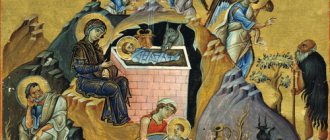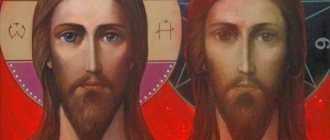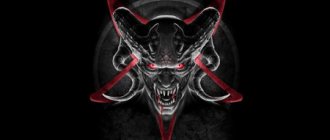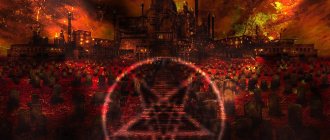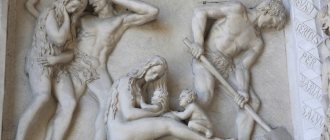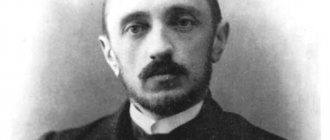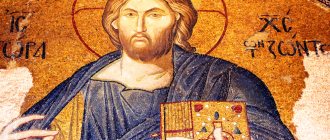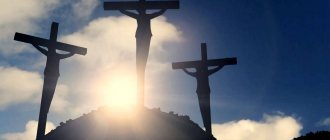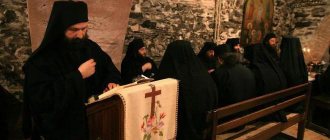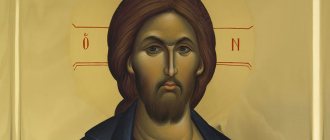In 1999, from the brush of the Russian artist Ilya Glazunov (born in 1930), a painting was released depicting the faces of Christ and the Antichrist. The image on the canvas symbolizes good and evil. Priest Andrei Ukhtomsky, candidate of theology, teacher of KDAiS, talks about this for PravLife.
I. Glazunov “Christ and Antichrist”
The artist's will
Daemon. For some reason, throughout his creative life, Vrubel returned to this image. And each time another one appeared on the canvas, different from the previous one: in his face there was either loneliness and melancholy, or despair. And finally, the last one appeared, “The Defeated Demon” - in him there was only anger and coldness. His gaze makes me shiver. “I believe that the Prince of Peace posed for him,” said Alexander Benois. “These sessions were pure mockery and teasing. Vrubel saw first one, then another feature of his deity, then both at once, and in pursuit of this elusive thing, he began to quickly move towards the abyss.”
Ilya Glazunov “Christ and Antichrist”: a painting with two faces
Ilya Sergeevich Glazunov, born in 1930, painted the painting “Christ and Antichrist” in 1999, this picture instantly became resonant, and disputes and disagreements still do not subside. The picture shows two faces; at first glance they are almost identical, but it only seems so. The image of Christ differs from the opposite face in its soft facial features, the image seems lighter, the color of the eyes is also different - on the good side they are blue. The Antichrist or devil depicted nearby looks similar to the Savior, but his embittered face, pointed beard and red eyes betray his vicious essence.
In order for the viewer to finally understand the essence of the image of good and evil, the artist focuses on the halos around the heroes of the canvas. Above the head of Christ, a standard halo, which is inherent in all religious icons, depicts a cross and the initials of the savior. Above the head of the Antichrist, there is also a halo similar to a holy halo, but its meaning is of a devilish nature. Here, instead of a cross, there is an inverted star, symbolizing the devil's gate, and three sixes are inscribed, which are considered the devil's number.
Art is our religion
Funeral lament. Sketch for the painting of the Vladimir Cathedral in Kyiv. 1887
Strangely, Mikhail Vrubel first began to paint the Demon at the time when he was painting the St. Cyril Church and making sketches for the Vladimir Cathedral in Kyiv. By order, he painted Christ, but in his free time, for himself, he turned to a completely different hero.
Emperor Nicholas I really liked the idea of building the Vladimir Cathedral in Kyiv, dedicated to the 900th anniversary of the Baptism of Rus'. Construction began in 1862, already under Alexander II, and lasted for thirty long years. Many artists were invited to paint the Vladimir Cathedral and the St. Cyril Church - Vasnetsov, Surikov, Polenov, Repin. Not all of them agreed. To paint real icons, you need authenticity of faith. Vasnetsov, who did the main work on painting the cathedral, studied at the Theological Seminary before the Academy of Arts. The son of a priest, he understood well what he was taking on. For him, work in the Vladimir Cathedral was “the path to the light,” the path to comprehending great values.
Mikhail Vrubel's attitude towards temple painting was completely different. Vrubel did not really know Christ, did not feel him. And Christ himself was for him neither the final truth nor the final depth.
“Art is our religion,” Mikhail Alexandrovich once remarked while working on one of the paintings that captivated him. “However,” he added, “who knows, maybe you’ll still have to be moved.” The temple for him was, first of all, a temple of art. He was attracted not by religious feeling, but by the scale and monumentality of churches.
While working in the Cyril Church, Vrubel admitted in a letter to his sister: “I draw and write with all the strength of Christ, and yet all religious rituals, including Christ’s Resurrection, are even annoying to me, so alien.”
It seems difficult to keep one eye on the ground and the other on the sky. Perhaps this is why the line between good and evil in Vrubel’s Kyiv works becomes too unsteady, the images of the earthly and the heavenly in his icons are too double.
Lilac. 1900. The height of Vrubel’s “demonic period.” Even delicate flowers pull the viewer into a funnel, into a stuffy purple twilight.
It was amazingly easy for Vrubel to paint a portrait of a circus rider in a muslin skirt who captivated him on top of “Prayer for the Cup,” only because there was no blank canvas at hand.
And in the image of the Mother of God, Vrubel openly reveals the features of an earthly woman - Emilia Prakhova. During his Kyiv days, Vrubel was painfully and unrequitedly in love with her.
And in the faces of his angels and saints there is little holiness. They are much more like spirits, menacing and disturbing.
Vrubel painted icons for the “Byzantine iconostasis” of the St. Cyril Church. But his sketches for the Vladimir Cathedral were not accepted. They were too different from traditional icon painting. It was a disaster. Vrubel dreamed of painting monumental canvases. Did not happen. He did not write Christ, but he will write the Demon.
The two faces have a slight difference in facial expression
The face of Christ is straight, open and calm; the devil's face is tense and somewhat embittered, his beard is pointed. Above the face of the Savior there is a round halo with a cross inscribed in it. The halo, depicted above the faces of Jesus Christ, the Mother of God and the saints (in the Byzantine tradition, the reigning person was depicted with a halo), symbolizes holiness and detachment from the outside world.
Above the image of the devil there is a halo, similar to a halo covered by the halo of Christ. Unlike the halo of Christ, which depicts the Cross, the image above the devil is an inverted star, a symbol of the devil, which is more clearly indicated by the three sixes located at the tops of the star. “Here is wisdom. He who has intelligence, count the number of the beast, for it is a human number; his number is six hundred and sixty-six” (Apoc. 13:18).
Demon Gallery
In the fall of 1889, Vrubel moved from Kyiv to Moscow. He really hopes that everything will turn out differently for him in Moscow. Vrubel becomes friends with the Abramtsevo circle and somehow quickly fits into Moscow life. He became, in the words of Konstantin Korovin, “Moscow’s chick.” He got acquainted with everyone, was a frequent guest of Moscow rich houses, where his company was loved. Mikhail Alexandrovich was well educated, graduated from St. Petersburg University, two faculties - law and history and philology, both with a gold medal, spoke eight languages.
Vrubel was a dandy. With his last money he could buy expensive perfume and, standing in a clay basin, doused himself with warm water and perfume. I visited the hairdresser almost every day. I almost cried when the cuffs were even slightly stained with paint. Sometimes he lived from hand to mouth, but he was always dressed exquisitely and elegantly. He often spent everything he received for his work in one day. I went to the best restaurant and ordered various delicious dishes. He was known as a gourmet, knew the brands of wines, what he was supposed to drink and after what.
It seemed that there was nothing demonic in Mikhail Alexandrovich Vrubel. He had great talent, and great passions raged in his soul. Konstantin Korovin said: one summer he and Vrubel went swimming, and Korovin saw large white stripes on his friend’s chest, like scars. When asked what it was, Mikhail Alexandrovich replied that he was cutting himself with a knife. “I don’t know if you will understand me, I loved a woman, but she didn’t love me, she even loved me, but many things prevented her from understanding me. I suffered, and when I cut myself, the suffering lessened.” We were talking about Emilia Prakhova.
Stranger to everyone
There was nothing demonic in Vrubel, and yet, why the Demon? Why does this image haunt him all his life? Even then, in Kyiv, in 1885, when the Demon first began to appear on canvas, Vrubel believed that his idol would make his name. Then he made dozens of different sketches and felt that it was not right. He tore it up, sketched what he had done and started all over again. He even decided to sculpt the Demon from clay: “... sculpted, he can only help painting.” In drawing, in painting, in clay, a whole gallery of demons unfolds, an endless demonic suite.
Flying demon. 1899
In Moscow, Vrubel receives an order to create illustrations for Lermontov’s collected works, including “The Demon.”
How often on the icy summit Alone between heaven and earth Under the roof of a fiery rainbow He sat gloomy and dumb...
Vrubel often quoted Lermontov by heart. I listened to the opera “The Demon” by Rubinstein. But it was important for him to find the image of his demon. It was as if he knew his thoughts and desires. And no longer by order, in the Morozov mansion, on Sadovo-Spasskaya, Vrubel painted “The Seated Demon.”
Demon sitting. 1890
On the canvas there is not an evil spirit or a crafty tempter. Vrubel painted melancholy. Supermundane melancholy and loneliness. His Demon is a stranger to everyone and everything. But he has inhuman power. He will not yield to anyone, either on earth or above earth. An unearthly landscape opens up around this lonely gigantic figure. A blue-purple tone covers the sky, illuminating the frozen masses of the mountains.
“There is no smile in the color lilac,” noted Goethe.
Remember the proverb “The road to hell is paved with good intentions”
This proverb goes back to the expression of the 17th century English theologian. George Herbert “Hell is full of good meaning and wishes” - “Hell is full of good intentions and desires.” The expression means that there are much more good intentions than good deeds. Because “there is a desire for good in me, but I don’t find it to do it. I don’t do the good that I want, but I do the evil that I don’t want. If I do what I do not want, it is no longer I who do it, but sin living in me. So I find it a law that when I want to do good, evil is present with me” (Rom. 7:18-21).
Above the crowd
For Vrubel, the creator, the artist, is always above the crowd.
He was chosen to “awaken the soul from the trifles of everyday life.” And most of human life is filled with trifles, nonsense and everyday life. This is why I am doomed to misunderstanding and endless loneliness: “I am an artist, but no one needs me. Nobody understands what I’m doing, but that’s what I want,” Vrubel complained to Korovin.
Vrubel’s father wrote about his son: “In conversations he revealed incredible conceit as an artist, a creator, and as a result did not allow any generalization, any measure, any comparison of him - the artist - with ordinary people.”
Demon and Tamara. 1891
“No comparison with ordinary people” - perhaps in this contemptuous look at an ordinary person, in the desire to assert oneself above the world, the demonic is revealed? Maybe this is the path to the Demon?
The monumentality and power of the entire figure is an affirmation of the strength and pride of man.
A motionless giant. He feels immensely sad in the deserted, closed kingdom of his own soul. Where is the way out of this isolation? Where is that one ray that will illuminate and resolve everything? The great artist Vrubel has the breath of the era through his personal life. Blok will see in Vrubel’s demons a prediction of the fate of the Russian intelligentsia at the turn of the century. The creators of the Silver Age, they knew the transition of light into darkness.
Elizaveta Karavaeva-Kuzmina, who went down in history as Mother Maria (Skobtsova), wrote about those intellectual gatherings and ferments that she knew about first-hand:
“I remember one of our first visits to the “Tower” of Vyacheslav Ivanov. All of Russia is sleeping. Midnight. There are a lot of people in the dining room. There is probably not a single ordinary person here, a person in general or just a person. We haven’t even had time to say hello to everyone, and Merezhkovsky is already shouting to my husband: “Who are you with—Christ or the Antichrist?!” And the dispute continues. Everything is out in the open, everything is almost shameless.
A cab's horse runs at a small trot along the sleepy streets.
Some kind of drunkenness without wine. Food that doesn't fill you up. Longing again."
The melancholy of Vrubel's Demon. The intelligentsia at the turn of the century. They made an idol out of art, deified themselves as creators. Food that doesn't fill you up.
Six-winged Seraphim. 1904. The painting was painted after Vrubel’s spiritual turning point. The demonic veil falls, the artist gains prophetic vision.
“My dear woman, wonderful woman, save me from my demons...” - this is what Vrubel will write to his wife, Nadezhda Zabela, almost at the end of his life, while in a psychiatric hospital.
Zabela became for Vrubel a bright angel who warmed, inspired, and saved from loneliness. When they got married, Vrubel was 39. Fate opened the next page. Some general disorder, which many remembered, left his life.
After meeting with Zabela, Vrubel stopped painting the Demon. The purple twilight dissipated. It was as if he had been freed from demonic spells and oppression. Everything around him and in himself became brighter. And the usual scolding of critics was perceived differently - easier.
When he met Nadezhda Zabela, a scandal broke out over the panels “Princess Dreams” and “Mikula Selyaninovich”. Vrubel presented these huge panels commissioned by Mamontov to decorate the art pavilion at the All-Russian Exhibition in Nizhny Novgorod. “Princess Dreams” is the eternal dream of artists about beauty. And “Mikula Selyaninovich” is the strength of the Russian land. The academic jury did not accept Vrubel's work. Critics said: “decadent ugliness”! The angry Mamontov is building a separate pavilion for these panels.
“I couldn’t figure it out, but I felt something animalistic in the hearts of the audience,” Korovin recalled. “I listened to the curses they uttered while looking at these panels. Mikhail Alexandrovich became even more convinced of his non-recognition and felt even more like an orphan of this life.”
“The Seated Demon” and Vrubel’s illustrations to Lermontov’s poem were also criticized. Many people scolded him, but there were also those who felt this strong, special gift and could not help but bow to it. Among them was Savva Mamontov, in whose private opera Nadezhda Zabela sang.
She became the muse of the composer Rimsky-Korsakov and performed the roles of the Snow Maiden, the Swan Princess, and Volkhova.
And soon this entire fabulous family will come to life in Vrubel’s paintings, stage costumes, and sculptures.
Zabela sang the Sea Princess 90 times, and Vrubel was present at the performance 90 times.
He idolized his wife. As an esthete, I could not help but admire her voice. He designed stage costumes for her and painted sets for operas.
It was a bright, harmonious time in Vrubel’s life. He wanted integrity and clarity of being.
Now he reaches out to the original Russian folk: “The Sea Princess,” “Thirty-three Bogatyrs,” majolica “Snow Maiden,” “Kupava,” “Sadko.”
In response to all accusations of decadence, Vrubel writes his “Bogatyr”. Stumpy, earthy, powerful - the salt of the Russian land.
LiveInternetLiveInternet
Christ and Antichrist. The secret name of Christ is Lucifer. (new ed.) The illustration shows Valery Tyrnov’s decoding of Nostradamus’s drawing about the beginning of the Apocalypse, after the death of Christ in 2026. If the Guardian of Russia is born, the date is pushed back to 2047. The rest of the pictures can be viewed at the links: https://polit-forum.ru/showthread.php?...#post41074 https://litzona.net/forum/viewtopic.php?f=4&t=2326 Probably many readers know about that on September 21 of this year, the prophecy of the 18th century Abel icon should be fulfilled, which indicated the date when Christ was supposed to “knock on the doors of Russia.” I proposed to the “weak”, never winning parties of Zyuganov, Zhirinovsky, Yavlinsky and others, as well as the BF forum, to organize a Conference for the Poet Black George, the “Master of Loud Poems”, the founder of the modern trend in Psychedelics. However, all my good attempts to persuade the Russian public were in vain, which indicates Russia’s deafness to the Voice of God, ignoring the Bulletin of Russia and the News of the coming of Christ. Moreover, on the BF forum, a mocking Conference was organized for the incarnate Christ in the bullpen section, which had the goal of humiliating and making a laughing stock, which was very reminiscent of the situation of the warlocks mocking and ridiculing Christ 2000 years ago. But then the mockery rained down for Christ in reality, and in the computerized 21st century, virtually, which does not change the essence of the matter. Nostradamus warned in a quatrain that if the conditions of the Prophecy of the Icon of Abel are not fulfilled, then the Antichrist will appear. Lucifer is the second secret name of Christ, which was revealed to me in a prophetic dream in the spring of 2010. Thus, the Antichrist is Lucifer - the second flip side of Christ. No matter how strange it may sound to some believers, Nostradamus confirms this fact from the life of Christ in drawings from the Lost Book. Thus, the godless political public of Russia did not heed the voice and warning of the Bulletin of Russia and did not open the political doors for the knocking Christ, the Poet and the Master of “loud verses” (Nostradamus). What should Christ do in this case? Should HE abandon the Providence of God and the prophecy of Nostradamus, which says that Christ should revive the monarchy in Russia and become the Tsar of Russia? All the righteous and saints of Russia prayed to God for this. *Drawing of Nostradamus, where Christ, in the role of Teacher, sits on the royal Romanov throne: Nostradamus says that Christ will not deviate from the Providence of God and the prophecy of Nostradamus. Christ will appear in Russia under his second name of Lucifer and will play with politicians according to their own rules, and most likely, without rules. Nostradamus's drawing of the Antichrist, where the Antichrist is girded with a thick hoop, in his hand the Cross is inverted: at his feet is the severed head of the Lamb; The Serpent has sunk its teeth into the hand - the image of the Ophiuchus of the Virgin Mary. Mary the Virgin will oppose the Antichrist and his team of seven Fallen Angels: A portrait of the Antichrist from Western Christian literature, something like this: The former cardinal of Bologna, Giacomo Biffi, preached to Pope Benedict XVI during traditional spiritual exercises, where he declared that the Antichrist would appear in the world in image of a “pacifist, ecologist and ecumenist.” “And he was given the image of a beast”: The 78-year-old prelate was known as a representative of the most conservative circles of the Vatican. According to him, “the masses will follow the Antichrist with the exception of small groups of Catholics, Orthodox and Protestants who will fight the destruction of the faith.” Giacomo Biffi argues that the Antichrist will not necessarily come in the form of a person, but can also manifest itself in “the transformation of Christianity into a set of ideological norms.” Acts of the Antichrist: The main features of the Antichrist, according to the cardinal, will be his defense of so-called human values, active struggle for peace, for human and animal rights. Biffy claims that Satan will be an activist of one of the green parties and a supporter of vegetarianism. In his opinion, the coming of the Antichrist was accompanied by the following historical events: the Holocaust, the extermination of Armenians by the Turks in 1915, Stalin's repressions in Russia and the sexual revolution. The all-joking Tsar-Antichrist Peter, who was in fact the incarnation of the Devil, and his wife, from under the soldier’s cart, was the Devil. While the real Tsar Peter found himself on a foreign trip in prison with an iron mask on his face, the place of the Tsar was taken by the Devil incarnate: the Bronze Horseman - the monument to Peter 1, which was ordered by Tsarina Catherine 2, gives a hint that Peter 1 is really , there is the Devil incarnate, who stole the throne and crown from the real Tsar Peter. The horse of the Bronze Horseman flattened a huge Snake with its hoof, a symbol of Holy Rus' and the Mother of God Virgin Mary Ophiuchus:
The fact that Tsar Peter 1 was the incarnation of the Devil confirms the biblical prophecy of the prophet Daniel about Nebuchadnezzar’s dream about the Idol and his Kingdom of Brass. The Copper Kingdom is a metaphor for ancient poor, impoverished Russia in the 17th century - Holy Rus', where the Devil came to rule, who managed to replace the real Tsar Peter with cunning and meanness. The Prophet Daniel was given a vision showing the course of world history until the establishment of the Kingdom of God. This prophecy is also known as the “Dream of Nebuchadnezzar,” the king of Babylonia who conquered the Jews in 607 BC: “Daniel answered the king and said: The secret that the king asks cannot be revealed to the king... but there is a God in heaven who reveals secrets; and he revealed to King Nebuchadnezzar what would happen in the last days... You, king, had such a vision: behold, some kind of large idol; This idol was huge, it stood before you in extreme splendor, and its appearance was terrible. This image had a head of pure gold, its chest and arms of silver, its belly and thighs of copper, its legs of iron, its legs partly of iron and partly of clay. Thou sawest him until the stone was torn out of the mountain without the aid of hands, and struck the image, his feet of iron and clay, and broke them in pieces” (Daniel 2). Thus, we can assume that by ordering a copper monument to Peter 1, Tsarina Catherine2 gave future descendants a hint about WHO the hard-hearted Tsar Peter1 really was - the Devil. In The Urantia Book, the New Testament for Russia, he is called the Devil Caligastia, and Nostradamus calls him the Dead Father and the Dead Conspirator. The Passion of the Antichrist: The first essentially attempt to give a coherent description of the coming of the Antichrist can be found in the work of Irenaeus of Lyons (135-202) “Refutation and refutation of false knowledge.” In several chapters, Irenaeus outlined the general contours of the doctrine of the Antichrist, and also taught its main sources: the Book of Daniel , Second Epistle to the Thessalonians of the Apostle Paul, Revelation of John the Theologian. The Life of the Antichrist the Sinner: It is characteristic that Lactantius calls the villain the Antichrist only once, and only at the end of the story. The usual designations for him are: “mighty king”, “wicked”, “tyrant”. This use of words is not accidental. Lactantius addressed the general public, the Roman citizens of his day, for whom the term “Antichrist” itself was not doctrinal and could not evoke appropriate emotions. “This king, filled with the greatest malice,” notes Lactantius along the way, “will, moreover, be a false prophet, proclaim himself God and command that he be adored as the Son of God.” Please note that the words of Lactantius about the “false Antichrist” and the words of Nostradamus about the “false Antihirst” completely coincide in meaning. Because the false and counterfeit Antichrist is not the real Antichrist, but Christ himself under the second name of Lucifer. Today's readers may find it strange to compare the Antichrist in foreign Christian literature with the name of the double Antichrist-Nero. But it did not embarrass Commodian’s contemporaries. It is worth comparing this seemingly obvious tautology with the remark of Lactantius in the essay “On the Deaths of the Persecutors” that Nero will return at the end of the century to be the forerunner and guide of the Antichrist (II 8, 9). The resurrecting Nero of Commodianus is the predecessor of the real Antichrist - the second Nero, suddenly appearing in the East and breaking into the Roman Empire. The Coming of the Antichrist: Many church authors, in one way or another, followed the already established scheme, which included the following basic provisions, which I give with my comments: 1) The Antichrist will be a Jew; According to my information, Black George’s father is Russian and his mother is Jewish. 2) Born into the tribe of Dan (Jeremiah 8:16). Signoronelli. Preaching of the Antichrist: 3) He will have an assistant - a false prophet (Rev 13:11); A false prophet, that is, NOT a prophet. In fact, not a helper, but the Messenger of Russia, the Comforter, the Judge and the Seventh Angel of the Apocalypse, who does not blow trumpets, but pours water into the ancestral font of the Virgin Mary. Christ sent the Messenger and Comforter ahead of himself, as evidenced by the words from the text of the Apocalypse: 7. “But I tell you the truth; It is better for you that I go; for if I do not go, the Comforter will not come to you; and if I go, I will send Him to you." Thus, following from the words of Christ from the Revelation of John the Theologian, a logical conclusion is drawn: If there is no Christ and he did not come, then there is no Comforter and Heir of Prophecy, - “The Comforter will not come to you ;" BUT the Comforter has come and “pours water”, that is, gives information and NEWS about CHRIST in RUSSIA!!! This is clearly visible in the 18th century icon of Abel, where the Messenger without a halo, kneeling, pours water from a vessel into the ancestral font of the Mother of God. That is, it gives information about the coming of Christ. Icon of Abel. Mother of God. 4) His main allies: Edom, Moab, Ammon (Dan 11:41). In the drawing of Nostradamus, the image of Lucifer is given in the form of a winged Dragon, who came to earth for the Sword-Kladenets. The sword is a symbol of strength. On the icon of Abel - the Mother of God - it is clearly visible that the image of Christ is half covered with clothing. This is a symbol and sign that the power of Christ is only half, 50%. Christ lost his power 12,000 years ago, when he was the god Osiris and died, dismembered into 14 parts. All parts of the body were spread to all directions of the world. Christ-Osiris was resurrected by HIS wife, the Virgin Mary, who at that time was the goddess Isis. But she was only able to resurrect Christ by half, - 50% The final Resurrection of Christ must occur in our 21st century. It was precisely for his strength that Christ came to Russia. The Dragon is a generalized image of the seven fallen angels with Lucifer: Edom, Moab, Ammon, Beelzebub, etc. The images of the seven Fallen angels with raised hands can be seen on the Sumerian-Akandan stele in the second line, where Christ is in the image of a Goose, on the left: 5 ) He will reign in the Roman Empire (Rev 17:11) That is, he will reign in Russia, which is considered the Third Rome. 6) Defeat three kings: Egyptian, Libyan and Ethiopian (Dan 11:43). 7) The Jews recognize him as their Messiah (John 5:43); He will rebuild the Temple of Jerusalem (=and sit in it) (2 Thessalonians 2:4), 9) He will set up his image (“image”) for public worship (Rev 13:14), 10) He will brand people, that is, he will apply a special seal on the forehead and right hand (Rev 13:16); 11) Will especially persecute Christians (Dan 7:25; Rev 13:7); Not to persecute, but to give the Christian New Testament of The Urantia Book. Nostradamus’s drawing of the Golden Ark, on which Russia and its people will “swim” after the Apocalypse into a new era, where God, the Guardian of Russia, will live with the people. Christ, in the red robe of Santa Claus, holds in his hands the New Testament, the Urantia Book: This is HE, - this is written in English in the open Book in the drawing of Nostradamus: This is HE, the Lord and Creator of our Universe, Christ. Christ will be a Teacher and will teach his flock the New true Christian religion according to the Urantia Book. This can be seen from the drawing of Nostradamus, where the barefoot Christ gives knowledge and books to his disciples: 12) He will kill the appearing prophets Enoch and Elijah (Rev 11: 3-10). 13) His reign will be three and a half years (Dan 7:25; Rev 13:5). Nostradamus in the Lost Book made a watercolor of a drawing showing the death of Christ and HIS ascension to heaven: The date of Christ's death was encrypted by Nostradamus in his Message. The modern translator Valery Tarnov deciphered the date of the Apocalypse after the death of Christ in 2026. There is the date of the death of Christ, which Tyrnov calls the date of the Apocalypse - 2026. If the Guardian of Russia is born, the date is pushed back to 2047. Nostradamus Cipher in a Letter: Decoding and drawing by Valery Tyrnov of a letter from Nostradamus: 14) He will be killed by Christ himself at the second coming (2 Thess. 2:8; Rev. 19:19-21). Christ cannot kill himself, and therefore paragraph 14 is invalid. The Sun Goddess is the Mother of God Mary the Virgin, opposing the Red Dragon Antichrist: Thus, we can say that over the long centuries that have passed since the crucifixion of Christ on Calvary, a wonderful alloy of popular prophecies and oracles, quite contradictory and even mutually exclusive, has accumulated in Christian literature about the Antichrist. But it could not have occurred to anyone that the Antichrist would be Christ himself under the secret name Lucifer?!! Could it be possible to imagine that in Russia there would be deaf people to the Voice of the Messenger and would not open the door to Christ knocking on the door on September 21, 2011? From the life of the icon of Abel. Christ in the robe of the Black Monk - Poet and Master Black George - knocks on the doors of Russia on September 21, 2011: Prophetic icon of Abel 18th century about the return of Tsar Nicholas to Russia under the name of Christ-Antichrist-Lucifer:
Series of messages “My criticism”:
Part 1 - Is Zyuganov a Mason or not? Part 2 - New Year's address of the Bulletin to the people of Russia and to the presidential candidates... Part 7 - Blavatsky's Key in the belly of the Virgin Mary. Part 8 - No title Part 9 - “Christ and Antichrist. The secret name of Christ is Lucifer" Part 10 - No to Presidential Elections - there is an Alternative to Christ!!! The King is coming!!! Part 11 - Sumerian Inana - a terrible cry. The look of death. Queen of Heaven from Hell. ... Part 18 - A block of literary flocks about creativity and Black George Part 19 - The Bulletin's appeal to the Consul General of Russia in Osh, Kyrgyzstan. Part 20 - About infighting and the crisis of modern poetry and literature. Declarators.
Sign of fate
And yet, even in Vrubel’s fairy tale paintings, a background is visible - alarming and eerie. There is duality and slyness in Vrubel’s “Pan”. Is he a good-natured old man from the forest or a magical goblin with transparent eyes, turned out of tree bark and roots?
And the landscape of the painting “Towards Night” breathes mysterious, alarming. There is an otherworldly force in everything. Even Vrubel’s “Lilac” draws the viewer into a funnel, into a stuffy, purple twilight.
No lordship. There is increasing anxiety and tension everywhere.
A strong, special gift as an artist, but a kind of defenselessness of the soul against the forces of darkness.
“Take me somewhere, otherwise I’ll cause trouble for you...” - Vrubel will say after the funeral of his son, Savva. The child did not live even two years. Mikhail Alexandrovich was then taken to a psychiatric clinic in Riga, then placed in the Serbsky clinic in Moscow.
Blok remarked: “The little that I have heard about Vrubel is more like a fairy tale than ordinary life.”
Sometimes like a fairy tale, and sometimes like a parable. Well, it seemed that Vrubel was a dandy and an esthete, for whom the ultimate truth was beauty. Is it a coincidence that his son is born with a congenital deformity - a cleft lip? And Vrubel, who created a cult of beauty, experiences this sign or clue of his fate so hard and terribly.
On the eve of the birth of his son, Savva, in 1899, Vrubel again took on the image of the Demon. A completely different demon is born in the artist’s soul. At that time, the first translations of Nietzsche’s atheistic works had just appeared in Russia. Ibsen's dramaturgy became fashionable.
Angel with censer and candle. Sketch for the painting of the Vladimir Cathedral in Kyiv. 1887
A new hero is being cultivated, free and powerful. A person who has an effective will to resist a society that is trying to enslave and depersonalize him.
The trouble is that the sublime mission of the new hero often sweeps away ordinary people and, in general, everything human on its “high” path.
...And now a new mask of the Demon is visible. This time it is not a mournful young man in the arms of world melancholy and loneliness.
Vrubel passionately takes up his work. In incredible excitement, he sends a note to his admirer, Mr. von Meck, who bought his paintings:
“Help and quickly get photographs of mountains somewhere, better than the Caucasus. I won't sleep until I get them."
One night, desert mountain ranges grew on the canvas behind the figure of the Demon. The unearthly cold and lifeless peace of this landscape. All. Humanity is impossible here.
In the end, Vrubel left the work unfinished. The reasons are not entirely clear.
In the flight of the Demon, instead of the intended feeling of power and freedom of spirit, there is a feeling of catastrophe, the threshold of the end. It seems that something appeared on the canvas, against the will of Vrubel himself: perhaps what the “liberated” nihilist man carries with him.
Then they will write that Vrubel brilliantly saw the spirit of Evil that hung over Europe at the turn of the century. He caught then the barely audible, underground rumble of future upheavals.
Not many years will pass - and this roar will burst out. Builders of happiness for future generations will march across Russia in orderly ranks. And over a confused, frightened country, where there is hunger, communal services and devastation, Mayakovsky’s voice will thunder like thunder: “Down with your love! Down with your art! Down with your system! Down with your religion!”
That's later. In the meantime, in 1899, the powerful Demon on Vrubel’s canvas flies directly at the viewer, and features of torment and doom appear in his appearance.
Darkness
The image of the Demon as a freedom-loving rebel came into art only after romanticism. The New Testament texts completely abandon graphic images of Satan. Theological literature does not describe the appearance of the devil or uses metaphors. On the contrary, folklore and fine arts pay great attention to this. In the Middle Ages, when depicting Satan, they endowed him with a gigantic body of incredible size, animal features, and multi-armedness. But it was always an image of evil and darkness.
Prophet's head. 1905 The demons are already behind us. He looks at the world not with contempt, but seeing the beautiful mystery and depth of life itself.
XVIII-XIX century. In art - the era of romanticism with the depiction of strong (often rebellious) passions and characters. The image of Satan becomes almost positive. The demon as a symbol of a lone rebel challenging an ossified society. A whole gallery of rebellious demons appears in art - both in Byron and in Lermontov.
Vrubel is the heir to this tradition.
At one time, Lermontov got rid of his demonic hero relatively easily.
And this wild nonsense haunted my mind for many years. But I, having parted with other dreams, And got rid of him - with poetry!
For Vrubel, everything turned out much more tragic. The painting “Demon Flying” remained unfinished. But the image of the Prince of this world again completely controls the artist. The demon is looking for his new incarnation.
In December 1901, another painting appeared - “The Defeated Demon.” Vrubel rewrites his canvas again and again, without stopping work even at exhibitions in Moscow and especially in St. Petersburg. On the canvas there is an inverted body, as if under torture.
Vrubel hoped that the Tretyakov Gallery would acquire the painting. Artist friends, on whom the acquisition of his treasured painting depended, criticize the incorrect anatomy in the depiction of the Demon’s figure. Vrubel was furious. Having lost all tact, he openly insulted Serov, Ostroukhov and even his wife. Ostroukhov, a member of the Art Council of the Tretyakov Gallery, wrote about this:
“Vrubel tormented me so much with his scenes that I can’t calmly watch another of his works, every peacock eye of the Demon’s wings seems to scream to me with Vrubel’s nervous cries...”
Mikhail Alexandrovich worked on this painting in an incredible nervous frenzy. He did not follow anatomical correctness. Realism was not important to him. Finally he found the one he was looking for - his truly tragic Demon. His twisted, broken body is a metaphor for the internal torment he has experienced, the struggles of the spirit. The strong, sublime in the creative person is crushed and trampled under foot by the ponderous foundations of society. This man is hunted, defeated, but not broken. He continues his battle with God, with the world, with people. There is no reconciliation, and strength is gathering in the soul for a new uprising.
Vrubel intends to go to Paris and exhibit his “Demon” there under the title “Icon”.
While working on this painting, Mikhail Alexandrovich will fall into real spiritual darkness. Those who saw him in those days at an exhibition in St. Petersburg were shocked by what was happening. However, it is better to give the floor to eyewitnesses. Alexander Benois recalls:
“Every morning, until 12, the public could see how Vrubel “finished” his picture. There was something terrible and monstrous in this last struggle. Every day we found new and new changes. The Demon’s face at one time became more and more terrible and more terrible, more painful and more painful.”
But it seems that the spirit that Vrubel was captivated by and exalted, mocked him himself.
After the euphoric upsurge of work, Vrubel falls into severe depression. The artist's mind cannot withstand the incredible creative stress. In April 1902, Vrubel was admitted to a psychiatric hospital. Mikhail Alexandrovich’s illness is mysterious. Many things played a role in this breakdown: misunderstanding of Vrubel by fellow artists, deafness to his quest. And, of course, the exhausting creative struggle in which Vrubel tried to capture the essence of the Demon. But the Demon constantly changed, eluded, and this duel becomes an obsession for the artist.
Or maybe the fluidity of essence is the essence of the demonic. Everything doubles and triples, nothing can be found on solid ground. The discovered truth soon turns into a crafty deception.
